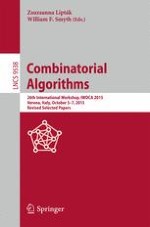This book constitutes the thoroughly refereed post-workshop proceedings for the 26 International Workshop on combinatorial Algorithms, IWOCA 2015, held in Verona, Italy, in October 2015.
The 29 revised full papers presented were carefully reviewed and selected from a total of 90 submissions. The topics of the papers include algorithms and data structures (including sequential, parallel, distributed, approximation, probabilistic, randomised, and on-line algorithms), algorithms on strings and graphs; applications (bioinformatics, music analysis, networking, and others); combinatorics on words; combinatorial enumeration; combinatorial optimization; complexity theory; computational biology; compression and information retrieval; cryptography and information security; decompositions and combinatorial designs; discrete and computational geometry; graph drawing and labeling; graph theory.
